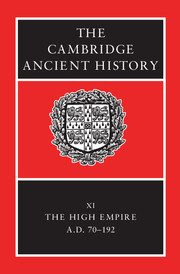Book contents
- Frontmatter
- PART I NARRATIVE
- 1 The Flavians
- 2 Nerva to Hadrian
- 3 Hadrian to the Antonines
- PART II GOVERNMENT AND CIVIL ADMINISTRATION
- PART III THE EMPIRE
- PART IV ROME, ITALY AND THE PROVINCES
- PART Va ECONOMY AND SOCIETY
- PART Vb ART AND CULTURE
- Chronological Table
- BIBLIOGRAPHY
- Index
- 1 The Roman world in the time of Marcus Aurelius
- 7 The Danube provinces
- References
1 - The Flavians
from PART I - NARRATIVE
Published online by Cambridge University Press: 28 March 2008
- Frontmatter
- PART I NARRATIVE
- 1 The Flavians
- 2 Nerva to Hadrian
- 3 Hadrian to the Antonines
- PART II GOVERNMENT AND CIVIL ADMINISTRATION
- PART III THE EMPIRE
- PART IV ROME, ITALY AND THE PROVINCES
- PART Va ECONOMY AND SOCIETY
- PART Vb ART AND CULTURE
- Chronological Table
- BIBLIOGRAPHY
- Index
- 1 The Roman world in the time of Marcus Aurelius
- 7 The Danube provinces
- References
Summary
VESPASIAN
‘During the whole period of his rule he considered nothing more essential than first to make firm the state, which was tottering and almost in ruins, and then to adorn it’. This characterization of Vespasian by his biographer Suetonius contrasts sharply with his description, in similar words, of the emperor Claudius attempting to erase from memory the mere two days of instability that had succeeded the assassination of his predecessor. Indeed, nothing comparable to the disruption of a.d. 69, with three emperors meeting violent deaths, had confronted any of the successors of Augustus.
The natural comparison to make is between Vespasian and Augustus himself, for the civil wars which ended the Republic were much in people's thoughts at the time. Those had been worse in that they were prolonged and had involved much suffering in the provinces, where huge armies had fought, and in Italy, where large numbers of veterans had to be settled. But the later ones weakened Roman prestige on the Rhine and Danube frontier and left Vespasian with a Gallic secession still in progress. Worse still, there was actual fighting in Rome itself, which moved Tacitus to draw parallels with the earlier civil wars between Sulla and Marius. Not surprisingly, grim omens and religious superstitions gained credence, and the civil war itself could be viewed as a giant expiation and purification of the whole world.
- Type
- Chapter
- Information
- The Cambridge Ancient History , pp. 1 - 83Publisher: Cambridge University PressPrint publication year: 2000
References
- 24
- Cited by

